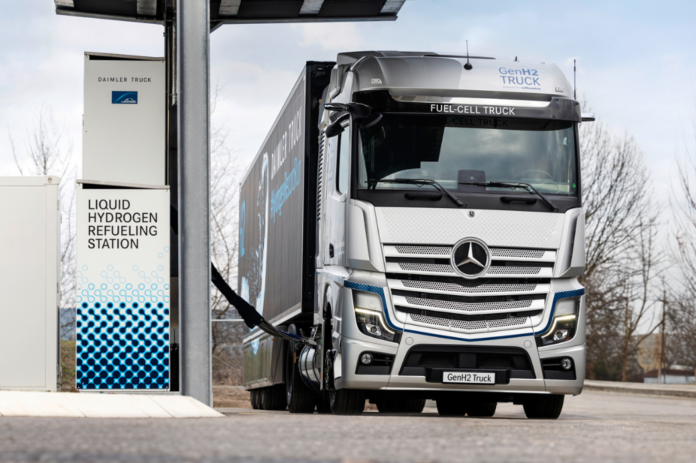Daimler Truck and Linde Engineering have reached an important infrastructure breakthrough on the path toward decarbonizing transportation with hydrogen.
Over the past few years, engineers from both companies have jointly developed sLH2, a new process for handling subcooled liquid hydrogen. Compared with gaseous hydrogen, this new approach allows for a higher storage density, a greater range, faster refueling, lower costs and superior energy efficiency. Refueling takes around 10 to 15 minutes for a 40-ton heavy-duty truck carrying 80 kg of liquid hydrogen for a range of 1,000 kilometers and more.
At the same time, the sLH2 technology lowers the required investment for a hydrogen refueling station by a factor of two to three, and operational costs are five to six times lower. Liquid hydrogen can now be supplied reliably throughout Europe.
Compared with regular liquid hydrogen (LH2) refueling technology, the new process uses a sLH2 pump to slightly increase the pressure of the liquid hydrogen. With this method, the hydrogen becomes subcooled liquid hydrogen (sLH2). Hydrogen in this state facilitates a robust fueling process that also keeps energy losses during refueling to a minimum. Furthermore, no data transmission between the refueling station and vehicle is necessary. At the same time, refueling capacity is increased to new levels because the pilot refueling station has a capacity of 400 kg of liquid hydrogen per hour.
Aiming to establish a common refueling standard for hydrogen-powered trucks, the technology has been made available to all interested parties via an ISO standard.
Andreas Gorbach, member of the Board of Management of Daimler Truck; and Juergen Nowicki, CEO of Linde Engineering, recently inaugurated the first public sLH2 pilot station in Wörth am Rhein, Germany, refueling a Mercedes-Benz GenH2 Truck prototype. Attending this event were Petra Dick-Walther, Rhineland-Palatinate’s secretary of state for Economic Affairs; and international media,
“Zero-emission transport needs three factors: the right battery electric and hydrogen-powered vehicles, the required infrastructure network and cost parity for ZEVs compared with diesel trucks,” says Gorbach. “In terms of vehicles, the transformation is in full swing. In terms of hydrogen infrastructure, we are reaching a major milestone today: With sLH2, hydrogen refueling becomes as convenient as today’s refueling with diesel. It takes about 10 to 15 minutes to fuel our Mercedes-Benz GenH2 Truck for a range of more than 1,000 kilometers. We now call on other OEMs and infrastructure companies to follow our approach and jointly make this technology an industry standard.”
“Subcooled liquid hydrogen considerably increases the efficiency of hydrogen refueling systems,” says Nowicki. “The required investment is reduced by a factor of two to three, and operational costs are five to six times lower. This and further advantages make sLH2 a practical, CO2-neutral alternative to diesel in the heavy-duty vehicle sector. The technology we have developed with Daimler Truck will help pave the way for the development of a robust refueling network, which is essential to keep vehicles moving and supply chains intact.”
The new public sLH2 refueling station in Wörth am Rhein, Germany, consumes only 0.05 KWh/kg of energy, or about 30 times less energy than conventional gaseous hydrogen refueling. The refueling station has a footprint of just 50 square meters (not including the dispenser) and permits configurations where several dispensers for parallel refueling of trucks are possible, as well as back-to-back refueling. The liquid hydrogen storage tank has a capacity of four tons, sufficient for approximately 10 hours of non-stop refueling. Meanwhile, the capacity of the sLH2 fuel station can be increased to over eight tons per day with refilling.
From mid-2024 onward, five companies are expected to take part in initial customer trials to gain first experience in CO2-free long-distance transport with Mercedes-Benz GenH2 trucks. The semi-trailer tractors will be deployed in different long-haul applications on specific routes within Germany, and they will be refueled at the public sLH2 refueling station in Wörth am Rhein and at a refueling station in the Duisburg area.






